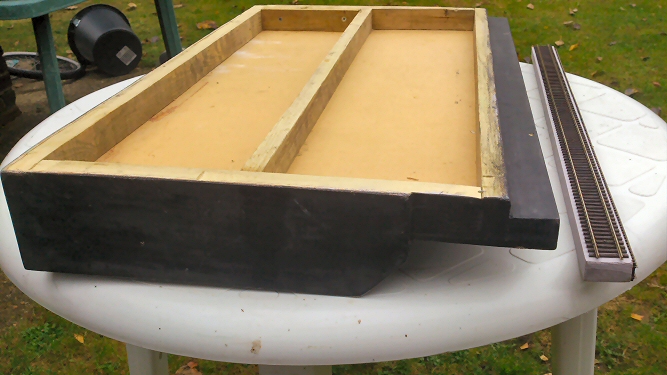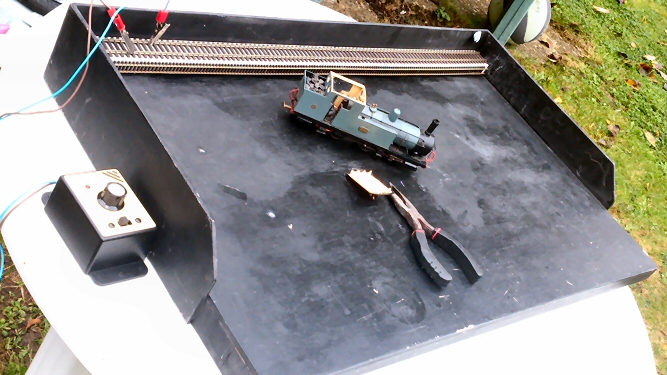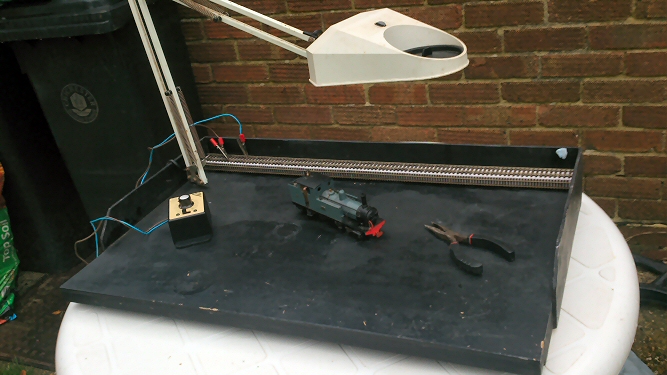
for latest news
Archived News
If News is not displayed here please click to see our Blog
Member Log-in
All members have now been advised of their log-in details by email or post. In the event of any problems please use the Contact Form to advise the Webmaster.

for latest news
Winter Workdesk by Doug Meany
Idea
The idea of a portable workbench came when it was evident that it was necessary, due to baby-sitting duties, for me to work in the house instead of the garage where the layout was located. The most likely location was the kitchen table but this was going to be a challenge as it was already a storage space for everything that went into the house plus groceries, clothing, books, paperwork, and, very occasionally was actually used for the purpose for which it was designed----eating meals. However---if I could push everything to one end (as opposed to putting everything away) I thought that I could just about use a small area for more important things, like modelling. But the dangers of leaving tools and materials unattended there for to long were so great that the only option was to be able to use or pack away at short notice. Enter the idea of a small(ish) bench on which I could model almost everything except the baseboards and fixed items. Something which could hold all those small bits and bobs and tools without the risk of them always disappearing or suffering damage and which could be easily moved from kitchen to garage or even into he car and down to the clubroom where work in progress could be continued.
Construction
It had to be light enough to be lifted and carried easily and small enough to be easily managed between locations so it was built, screwed and glued, with lightweight 4mm plywood (71cm x 45cms) on a 1.5" (4cm) x 1" (2.5cm) sawn softwood frame The frame was built slightly smaller than the plywood desktop measuring 71 x 40cm with a longitudinal member for strength, in the centre. Along the front of the under frame is a full length piece of 5x2.5cm sawn timber with a flat side glued and screwed to the frame and the underside of the baseboard, to form a lip. The whole unit stands 12cms high including the 4mm plywood side panels, which were added along the back edge and both sides, reaching to about10cms back from the front edge forming a lip about 8cms high around the baseboard top. At this stage the whole unit was painted with a grey primer then two coats of Satin Black one coat paint.
I have also made up test tracks for both (OO)16.5mm and (N)9mm by pinning lengths of track to two faces of a piece of 4 x 2.5cm sawn softwood, which I cut to fit between the plywood sides of the unit, then painted in grey primer. This test track is removable and simply turned to present the gauge required.
Usage
The workdesk has already proven itself to be a very useful addition to my "toolbox" and I have used it on several occasions both indoors and in the garage and at the clubrooms of Bognor Regis MRC. My plan was to equip it with all sorts of gadgets but have decided so far that all I need on it are a good light with a magnifying glass attached. I use an old anglepoise type which is temporarily fitted by inserting the base pin through a tight fitting hole near the back of the baseboard. If you prefer, you can easily use a clamp type flexible lamp/magnifier fixed to the worktop lip. I sometimes require a small vice and clamp one to the front lip of the desk. Depending what project I may be working on I keep in my toolbox a number of wires with either crocodile clips, washers or light bulbs attached to connect to a separate controller for testing loco's etcetera. I always keep a cutting board handy and several small empty yoghurt pots or butter dishes for small items which would otherwise get mislaid
I hope the photos are able to speak a thousand words and show what I have attempted to explain.
NOTE: This article can also be found at the website for the 7mm Narrow Gauge Association South Downs Group.


